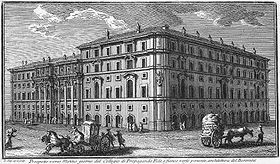
Palazzo di Propaganda Fide
Encyclopedia

Rome
Rome is the capital of Italy and the country's largest and most populated city and comune, with over 2.7 million residents in . The city is located in the central-western portion of the Italian Peninsula, on the Tiber River within the Lazio region of Italy.Rome's history spans two and a half...
, designed by Gian Lorenzo Bernini
Gian Lorenzo Bernini
Gian Lorenzo Bernini was an Italian artist who worked principally in Rome. He was the leading sculptor of his age and also a prominent architect...
, then Francesco Borromini
Francesco Borromini
Francesco Borromini, byname of Francesco Castelli was an architect from Ticino who, with his contemporaries, Gian Lorenzo Bernini and Pietro da Cortona, was a leading figure in the emergence of Roman Baroque architecture.A keen student of the architecture of Michelangelo and the ruins of...
. Since 1626, it has housed the Congregation for the Evangelization of Peoples
Congregation for the Evangelization of Peoples
The Congregation for the Evangelization of Peoples in Rome is the congregation of the Roman Curia responsible for missionary work and related activities...
and since 1929 is an extraterritorial property of the Holy See
Properties of the Holy See
The properties of the Holy See are properties of the Holy See which are regulated by the 1929 Lateran Treaty signed with the Kingdom of Italy. Although being part of Italian territory, all of them have an extraterritorial status, similar to those of foreign embassies.- Outside Vatican City but...
.
History
The building is located in the RioneRioni of Rome
A rione is an Italian term used since the Middle Ages to name the districts of Rome, according to the administrative divisions of that time. The word originates from the Latin word regio A rione (pl. rioni) is an Italian term used since the Middle Ages to name the districts of Rome, according to...
Trevi
Trevi (rione of Rome)
Trevi is the rione II of Rome. The origin of its name is not clear,but the most accepted possibility is that it comes from the Latin trivium, because there were three streets all leading to "piazza dei Crociferi",...
, at the southern end of Piazza di Spagna. Its southern facade is in front of the basilica
Basilica
The Latin word basilica , was originally used to describe a Roman public building, usually located in the forum of a Roman town. Public basilicas began to appear in Hellenistic cities in the 2nd century BC.The term was also applied to buildings used for religious purposes...
Sant'Andrea delle Fratte
Sant'Andrea delle Fratte
Sant'Andrea delle Fratte is a 17th-century basilica church in Rome, Italy, dedicated to St. Andrew. The Cardinal Priest of the Titulus S. Andreae Apostoli de Hortis is Ennio Antonelli....
, whose cupola and the bell were the work of Borromini. The main facade was created by Bernin (1644), and the front side of the via di Propaganda by Borromini (1646). This setting aside of Bernin's work was a request of Pope Innocent X, who preferred Borromini's style. The work was completed in 1667.
Description
The building houses the chapel of the Biblical MagiBiblical Magi
The Magi Greek: μάγοι, magoi), also referred to as the Wise Men, Kings, Astrologers, or Kings from the East, were a group of distinguished foreigners who were said to have visited Jesus after his birth, bearing gifts of gold, frankincense and myrrh...
, built by Borromini. On the outside, a ridge marks the separation between the ground floor and piano nobile
Piano nobile
The piano nobile is the principal floor of a large house, usually built in one of the styles of classical renaissance architecture...
. On the facade by Borromini, composed of pilasters, concave and convex curves in the windows design are alternating ; it is one of the most famous examples of Italian Baroque architecture
Baroque architecture
Baroque architecture is a term used to describe the building style of the Baroque era, begun in late sixteenth century Italy, that took the Roman vocabulary of Renaissance architecture and used it in a new rhetorical and theatrical fashion, often to express the triumph of the Catholic Church and...
.

